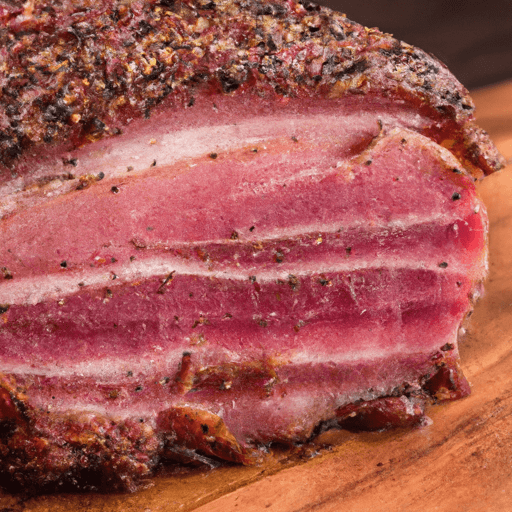Beef Brisket: A Flavorful and Versatile Cut of Meat
When it comes to mouthwatering meats, few can rival the deliciousness of beef brisket. This hearty cut, known for its rich flavor and tender texture, has become a staple in many culinary traditions around the world. In this article, we delve into the fascinating world of beef brisket, exploring its taste, common uses in cooking, nutritional value, and sharing some interesting history and facts along the way. So, let’s fire up the grill and discover what makes beef brisket so special!
Taste and Texture
Beef brisket boasts a distinct and robust flavor that is nothing short of sensational. This cut is derived from the chest area of the cow, which ensures a well-marbled piece of meat. The ample marbling enhances the flavor, providing a perfect balance between rich, juicy fat and tender, melt-in-your-mouth meat. When cooked correctly, beef brisket showcases a deep, smoky, and savory taste that is guaranteed to please the taste buds of meat lovers everywhere.
Culinary Uses
The versatility of beef brisket is truly remarkable. In many cultures, this cut is a go-to ingredient for various classic dishes. One of the most popular preparations is smoked beef brisket, which is quintessential to the world of American barbeque. Slowly cooked over low heat for hours, the result is a succulent, flavorful, and tender meat that falls apart with each bite.
Another well-known culinary application of beef brisket is corned beef. The brisket is cured in a flavorful brine, creating a delightful blend of savory and tangy notes. Corned beef is an integral component of traditional dishes like Irish corned beef and cabbage or the iconic Reuben sandwich.
In addition to barbeque and cured preparations, beef brisket can also be braised, seared, or roasted. Its versatility allows it to shine in a wide range of dishes, from comforting stews and casseroles to Asian-inspired stir-fries. The possibilities are endless when it comes to experimenting with beef brisket in the kitchen!
Nutritional Value
Beef brisket offers more than just a delightful culinary experience—it also provides essential nutrients to support a balanced diet. As a red meat, it is an excellent source of high-quality protein, which plays a crucial role in building and repairing tissues. It also contains a range of vitamins and minerals, including iron, zinc, and B vitamins.
It’s important to note that beef brisket contains varying amounts of fat, depending on the cut and cooking method. However, with proper portion control and balance in meals, it can be enjoyed as part of a healthy diet. Consider opting for leaner cuts or trimming excess fat before cooking to keep your meal balanced and heart-healthy.
History and Facts
Beef brisket has a rich history that spans across different cultures. It is believed to have originated from Central European Jewish communities, where it became a traditional dish for festive occasions. Over time, it migrated to various parts of the world, adapting to different culinary styles and giving rise to unique interpretations and recipes.
In Texas, the slow-smoked beef brisket is central to the Lone Star State’s barbeque culture. Pitmasters have perfected the art of cooking brisket low and slow, resulting in a legendary delicacy enjoyed by locals and visitors alike. The long cooking process allows the meat to develop a tender texture and an exceptional flavor that has earned Texas brisket its world-renowned culinary reputation.
Conclusion
Beef brisket is a true culinary gem that satisfies both meat enthusiasts and curious food lovers. Its bold flavor, adaptable nature, and ability to transform into a myriad of mouthwatering dishes make it an irresistible choice. Whether you prefer it slow-smoked for a classic barbeque experience or braised for a comforting meal, beef brisket is sure to captivate your senses and leave you wanting more. So, get your apron on, gather your ingredients, and embark on a brisket adventure that will elevate your cooking skills and delight your taste buds.
Interesting Facts About Beef Brisket:
Origin: Beef brisket refers to a specific cut of meat that comes from the breast or lower chest area of a cow. While it is commonly associated with American barbecue, it has a long history as a staple in Jewish, Irish, and Eastern European cuisines.
Common Uses: Beef brisket is known for its distinctive flavor, tenderness, and versatility. It is often cooked low and slow through smoking, braising, or slow roasting to achieve a tender and flavorful result. It is commonly used in dishes like smoked barbecue brisket, corned beef, pastrami, and slow-cooked stews.
Nutritional Benefits: Beef brisket is a good source of protein, vitamins, and minerals. It contains essential nutrients like iron, zinc, vitamin B12, and niacin. However, it is also important to note that beef brisket is a high-fat cut of meat and should be consumed in moderation as part of a balanced diet.
Unique Properties: One of the unique properties of beef brisket is its high collagen content. Collagen is a protein that breaks down into gelatin during cooking, which contributes to the tenderness and rich mouthfeel of a properly cooked brisket. It is also known for its marbling, which contributes to its flavor and juiciness.
Historical Significance: Beef brisket has a rich history in various cultures. In Jewish cuisine, slow-cooked brisket is a traditional dish served during holidays and special occasions. In Texas, USA, smoked barbecue brisket is considered an iconic dish, reflecting the state’s barbecue traditions. Furthermore, the popularity of beef brisket in Eastern European cuisines, such as in dishes like goulash or braised beef, showcases its widespread culinary significance.




Use the share button below if you liked it.
It makes me smile, when I see it.